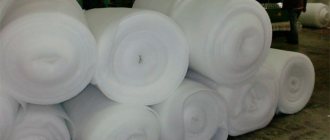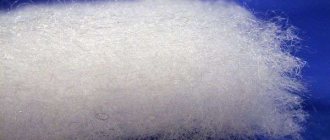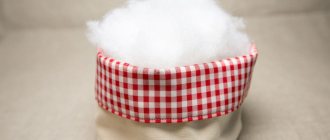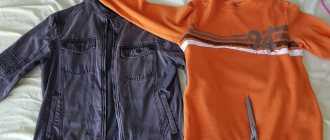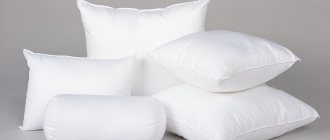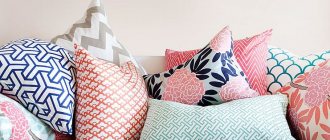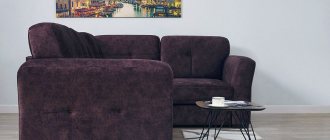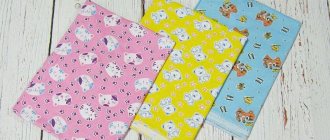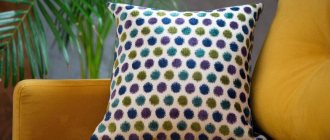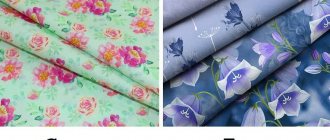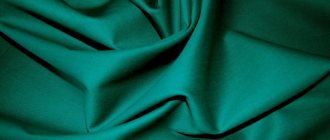The advantage of synthetic insulation is that they are hypoallergenic, they do not harbor microorganisms (mites, etc.), and clothes with various “fibers” (“fiber” is translated as “fiber”) inside hold their shape better and do not deform from washing, Keeps you warm and doesn't let cold air in.
So, let's deal with insulation without going into highly scientific jungle.
First rule
When you see a new, unfamiliar name, don’t rush! The manufacturer, trying to capture the attention of the consumer, comes up with its own (trade) names for insulation materials.
Consider the label on the jacket or overalls. Don’t be surprised if you see the inscription: “insulation – polyester 100%”. And where, you know, is that “fiberskin” or “polyfiber”?
Almost any synthetic insulation consists of polyester fibers. Thus, on the label you will read what the material for the insulation is made of, and more detailed instructions or a sales consultant should tell you what the name of the insulation itself is, what technology it is made of, and what this technology provides. Products from reputable companies have a special booklet where all the materials are described in detail and their qualities are indicated.
Second rule
80% of childhood colds are not to blame for the immune system, but for parents who do not know how to dress their child. For example, a child who often suffers from colds should never be re-wrapped, and it is absolutely forbidden to wear thick hats and tie tight scarves.
Not a single seller will be able to explain to you whether your child will freeze in just such clothes. All new generation synthetic fillers work on the same principle: they retain heat well. Look for (ask) an indicator of the permissible temperature (up to -10° or up to -40°).
Third rule
Remember that it is not the insulation that heats, but the air in its cavities. The lighter the fibers, the more cavities inside, the lower the temperature at which these clothes can be used. The best thermal insulator is air.
The label on a real down jacket should say “down”. This means that the fluff eider, swan or goose. 100% “down” is quite rare. Most often, feathers are added to it and written “feather”. If the label says “ cotton ,” then this is not a down jacket , but just lined jacket The inscription “ wool ” indicates that there is wool batting jacket , and the word “polyester” or “waltern” refers to padding polyester or its modern varieties.
TYPES OF INSULATION
Synthetic winterizer Synthetic winterizer is divided into two types: old (dense) and new (hollow). Both are made from polyester fibers. Bonding of fibers to each other is carried out thermally. Previously, synthetic winterizer was laid in parallel layers. Because of this, it had very low performance in terms of heat conservation and moisture conductivity. Nowadays, dense padding polyester (thick, adhesive ) is used only in cheap products. In the new padding polyester, the fibers are not glued together, but seem to be held together with the help of silicone needles. This insulation is more durable and does not lose its shape. But still, synthetic winterizer continues to yield to modern inventions. After exposure to sweat and washing, it loses up to half its thickness. And it is not suitable for cold winters - maximum, for temperatures down to -10°. Care: wash at 30°C, using only soft powders that do not contain bleaching agents; do not soak or bleach.
Thinsulate is considered one of the best insulation materials at the moment; its heat-saving properties are equal to down. Consisting of very fine fibers that retain heat excellently, overalls and jackets made with Thinsulate are light, thin and warm. It does not deform when washed, it can warm you in severe frosts, provided that the person moves, preferably actively. Thinsulate clothing is made for athletes, oil workers, and climbers. Thinsulate clothing usually Permissible temperature range for Thinsulate: up to -30°. Care: machine wash with spin at 40°. Holofiber, fiberskin, fibertech , polyfiber, isosoft...
Synthetic insulation made from fibers shaped like balls, springs, etc. Balls, spirals or springs do not communicate with each other and contain cavities, so the product holds its shape well. For a small price you buy a good overall that can withstand temperatures down to -25°. Care: machine wash with spin at 40°.
DOWN OR SYNTHETIC?
There are two main types of insulation used in jackets: down and synthetic. Both types have strengths and weaknesses that make them invaluable in certain situations.
| fluff | synthetics |
Regardless of their composition, all insulation works according to the same basic principle. Your body heat is retained in the air gap (small air containers) created by the insulation. This layer insulates your body heat from cold weather and keeps you feeling comfortable.
POOF
Down is obtained from the plumage of geese and ducks, namely from the fluffy layer under the feathers. Down has very little weight and effectively holds air. The warmth-to-weight ratio of down is considered unsurpassed today. In cold and dry weather, down is the warmest and lightest insulation in the world.
| The Achilles heel of down products is wet weather. When down gets wet, it loses its airiness and insulating ability. Even high humidity can reduce the effectiveness of down. In addition, it will take quite a long time for the down to dry. To minimize these disadvantages, waterproof down . |
Waterproof down
To protect down from getting wet, it is treated with a hydrophobic (waterproof) coating at the molecular level.
If you love the warmth, lightness and superior movement that down insulation provides and you occasionally deal with wet weather, then waterproof down is your option.
Each manufacturer has its own names for such down, for example: Marmot Down Defender, DriDown, Q.Shield Down, DownTek, Hydrophobic Down and others.
What is Fill Power?
Fill Power is the degree of elasticity, that is, the ability of down to restore its original volume after compression. When looking at down jackets, you will often notice 600 Fill Power, 700 Fill Power, 800 Fill Power and even 900 Fill Power ratings.
How is Fill Power measured? The independent laboratory IDFL, located in the USA, is responsible for measuring the degree of down elasticity and international certification. IDFL conducts the test:
- At a certain level of humidity and temperature, 1 ounce of fluff is taken, which is 28.4 g. The fluff is placed in a cylinder with transparent walls. The diameter of the test cylinder is 241.3 mm.
- A disk weighing 68.3 g and having the same diameter as the cylinder is lowered onto the fluff. The fluff is left under “oppression” for 3-5 days.
- When the disc is removed, the fluff expands and strives to occupy its maximum volume.
- The final volume of fluff is measured and its density is calculated, which is called the Fill Power indicator. Fill Power is expressed in cubic inches per ounce (in?/oz).
Fill Power is used to evaluate the quality of down. Higher down values indicate higher quality, and therefore greater warmth and airiness.
Interestingly, to create the same air layer, that is, the same degree of insulation, 800 Fill Power down requires 20-25% less than 650 Fill Power down. That is, the fuller, heavier 650 Fill Power down jackets provide just as much warmth as the thin, lightweight 800 Fill Power.
Insulation with a density of 150–250 g/m² - what kind of weather can an adult wear?
Everyone is familiar with the situation when in spring or autumn it is frosty in the morning, but warm in the afternoon and you don’t know how to dress. When buying warm clothes, you should check with the seller what the density of the filler is. The recommended density for the second half of autumn, when frosts begin and the temperature drops to -5 degrees Celsius, is 150 g/m². In winter frosts down to -20 °C, the optimal option would be a padding polyester density of 250 g/m². The data is relevant for adults, children do not have such a high heat transfer, but they are more active, overweight people freeze less than thin people.
Benefits of down
| minimum weight, |
| the highest heat capacity in the world, |
| excellent breathability, |
| high compression properties, |
| excellent durability (if the down is high quality). |
| Men's Jackets | Women's Jackets |
SYNTHETICS
Synthetic insulation is usually made from polyester, which is spun into special thin fibers to imitate the structure of down.
Even though synthetic insulation is not as warm as down, it still effectively traps warm air. Synthetic insulation is less durable than high-quality certified down. Unlike down, synthetic fill keeps you warm even when wet . This advantage makes it an excellent choice for damp or humid weather conditions.
How to choose a men's winter jacket by size
In fact, the size of the jacket should be one size larger than a classic jacket. If you don’t have one at hand, it is better to try on a down jacket in a thick sweater or jumper - this will give a 100% guarantee that even in extreme cold you will be warm, comfortable and not cramped. In addition, clothing should not restrict movement, the arms should rise freely, sitting and bending should also be comfortable. You can do a little “exercise” in the jacket - from the outside it may look a little funny, but you will be more confident in the correct size. To create a more beautiful silhouette, ensure that the shoulder seam of the jacket is just below your shoulder.
Advantages of synthetics
| high resistance to moisture, |
| good heat capacity, |
| light weight, |
| excellent durability, |
| relatively low price. |
| Men's synthetic jackets | Women's synthetic jackets |
Fillings in winter outerwear for children (helpful article)
Read about the material of outerwear uppers for children link
I tried to write as clearly as possible, considering the basic fillers.
ISOSOFT and TERMOFAB ISOSOFT is a modern European insulation from the original manufacturer Libeltex. Isosoft® is a unique high-tech insulation of a new generation, which has a high thermal insulation ability with almost imperceptible weight. Soft as feathers, Isosoft® is twice warmer than conventional synthetic insulation, easily restores its shape after compression and does not lose it even after numerous washes and dry cleaning. Isosoft® guarantees an excellent feeling of comfort during any activity. Does not cause allergies. Does not require mandatory dry cleaning. Easy to wash. Dries quickly. Gives a feeling of comfort both at + 5°C and at - 40°C. Has the effect of a thermos (retains body heat). Thanks to the constant introduction of the latest technologies, the Belgian company Libeltex, since its founding (since 1945), has successfully produced various insulation materials intended for outerwear and bedding. Its heat-insulating structure consists of many very fine fibers, thanks to which the products have excellent heat-protective properties, despite their apparent external thinness. The unique surface of the material allows you to combine Isosoft ® insulation with different fabrics, thereby reducing their wear life. With lightness, softness and small volume of the product, clothes with Isosoft ® insulation are always comfortable and warm. Advantages of Isosoft insulation when compared with down: • does not cause allergies; • does not require mandatory dry cleaning; • easy to wash; • dries quickly; • gives a feeling of comfort both at + 5°C and at - 20°C. Some companies: Lappi kids ICEPEAK Baby Club (also has down/feather) ZeroExposure Peary&Cook (also has Silk Touch and down/feather) Reima (Finland) Kerry (Finland) Lenne (Estonia) Gusti (Canada) Tilson (Norway)
BlissOne (Poland) TERMOFAB - 100% - polyester fiber, made using the latest technologies, has a voluminous fine-mesh (bubble-type) structure. New insulation, manufactured using the latest technologies, is recommended for use in particularly harsh climatic zones (at temperatures down to -35°C) Properties of Termofab - soft, warm, dries quickly, does not lose heat-protective properties after washing, easily restores its original volume, environmentally friendly and safe for children. YDI THERMOFIBER, HOLLOFAN, HOLLOFIBER and TINSULEATE (made from hollow fibers) THERMOFIBER - unlike traditional insulation like padding polyester, it is made of hollow, highly crimped fibers using heat-fixing technology. Each elementary fiber has an air cavity inside, which significantly improves the thermal insulation properties of the fabric due to the high thermal conductivity of air. The diameter of an elementary hollow fiber is 30% larger than that of a conventional fiber, which provides, with the same surface density, a greater volume of the web. Large diameter hollow fibers give the canvas better breathability. Tests for moisture capacity have shown that Thermofiber absorbs moisture 10% less than Sintepon and Thinsulate, which characterizes its lower moisture capacity along with a higher drying rate. Products with Thermofiber insulation retain their size and volume after washing and drying, heat-protective properties and air permeability practically do not change during operation. As a result, “Thermofiber” has an excellent combination of heat-protective and ventilating properties, high volume with a lower surface density. Thermofiber is an environmentally friendly product. Lemming HOLLOFAN - It is an interweaving of spiral-shaped hollow fibers that form a strong springy structure. This allows the product to retain its shape for a long time and easily restore it. In terms of heat-protective properties, HOLOFAN is as close as possible to natural down, but unlike down products, it is easy to wash, does not absorb moisture or odors, does not cause allergies, and is also able to retain the heat generated by our body, but does not “evaporate” it during prolonged use .
Features: -Lightweight! Warms well in cold weather - Does not cause allergies - Removes excess moisture - Maintains and quickly restores its volume during long-term use and repeated washings - Does not absorb odors and moisture VELFI OLDOS and JIKO Yoot HOLLEFiber - comes from the translation of the English words hollow fiber - “hollow fiber” , and means that the material is made from 100% hollow, highly crimped (coil spring-like) polyester microfiber. The connection (binding) of microfibers evenly distributed in the canvas occurs using thermal bonding (by melting low-melting fiber). This method is reflected in the name - “thermal bonded fabric”. In this case, a three-dimensional, “springy” structure of the material is formed, which recovers after deformation and compression. The elasticity and recoverability of the Holofiber fibrous structure is maintained when the material is used for a long time. To make the surface smooth and prevent fiber migration, the Holofiber material is calendered (on one or both sides). That is, the composition, structure and technology for producing non-woven bulk material “Holofiber” has much in common with the production of Thinsulate P. It does not absorb moisture, dries quickly, and protects from cold at temperatures down to -30°C. BILEMI EAST FAIRY TALE SKORPIAN Mariquita Alpex Donilo (Russia) THINSULATE - a unique ultra-light insulation of the new generation Thinsulate™ (from the English thin - thin, insulation - insulation) will protect your child from cold, rain and wind in our harsh Siberian climatic conditions. Consists Thinsulate™ is made from microfibers identical to the finest down fibers. The idea of creating such a material borders on art. Products insulated with Thinsulate™ provide comfort by trapping air molecules between the fibers. And the more air there is in a certain volume, the higher the thermal insulation of the insulation. So why The same property of Thinsulate™ insulation is unique? The more insulation fibers are in a unit volume, the more air the material is able to hold. Thinsulate insulation consists of unique microfibers, which are 50 - 70 times thinner than a human hair, their diameter is from 2 to 10 microns. Around each fiber is a layer of air that will warm your baby by trapping his body heat. The finer the fibers, the more insulating layers there are in the clothing. This makes Thinsulate™ insulation 2 times warmer than the warmest down. At the same time, it breathes well, does not become damp and can be easily washed at home without losing its properties. Thinsulate™ insulation has become a synthetic substitute for natural down, without at the same time having its disadvantages: the material’s ability to absorb moisture is less than 1%. Thinsulate reliably retains heat and allows excess moisture to evaporate freely. This insulation does not restrict movement and provides complete comfort even in the most severe frosts. Features of the Thinsulate™ filler • Warmth without excess volume (the light weight and small thickness of the Thinsulate™ filler makes it weightless and relatively non-volume); • 1.5-2 times warmer than natural fluff; • Higher breathability compared to down and feather products. The main thing in all insulation is the ability to retain air. The more bound air is retained per unit volume of insulation, the better it retains heat. For Thinsulate™ insulation, compared to other materials, this value is almost 10 times greater; • Greater thermal insulation effect than other polyester fillers of similar thickness and density; • Maintains the necessary balance of humidity; • Environmentally friendly and hypoallergenic material; • Resistant to moisture, washable; • Thanks to the three-dimensional bonding of fibers, it retains its unique properties and shape after many washes. Due to its high resistance to compression, the product does not bunch up or shrink after washing at 40°C (about 10% after multiple washes).; • Has the European environmental certificate Oeko-Tex Standart 100. Care : Machine wash with spin at 40°. Thinsulate insulation does not lose its properties after washing or dry cleaning if you follow 3M's care recommendations for the appropriate type of insulation. However, a different mode may be provided for the outer or lining fabric. Therefore, pay attention to the care recommendations from the manufacturer of the entire product. The new insulation, manufactured using the latest technologies, is recommended for use in particularly harsh climatic zones, at temperatures down to -35°C. Clothes on the tinuslate (as well as its analogues - Hollofil, Quallowfill, and Polarguard) are quite expensive. Permissible temperature range for Thinsulate: up to -30°. Ketch (Sweden), TALVI / Talvi (Russia) atPlay (Canada) DONILO Gulliver Heinrich Nickel GmbH (Germany) The above fillers are almost identical in terms of heat retention. THERMOLITE PLUS THERMOLITE PLUS - Developed by Dupont specifically for insulating clothing designed for cold weather. Made from 80% recycled polyester. It consists of interwoven hollow fibers of a special shape.
Thermolite® Plus is: High softness of insulation Continues to warm when wet High mechanical resistance Consistency of characteristics after a large number of washes Hypoallergenic new Can be washed/dried in a machine You can also read here Skorpain Arista KALBORN ArctiLine (Russia) DOWN/FEather DOWN /FEATHER is a natural traditional insulation, goose Down/Feather is a natural heat insulator in all weather conditions. It represents the most valuable layer of a bird's plumage and is lightweight, freely breathing, and easily absorbs a large volume of air. Natural down provides pleasant warmth, eliminating the risk of overheating. Down is able to quickly restore its volume and thermal properties after mechanical compression. It has a small transport volume of the finished product and its exceptional durability. Such unique properties can be explained by the structure of the fluff, consisting of individual fluffs, which, on the one hand, repel, and on the other, under pressure, enter into each other. It is one of the highest quality and most expensive fillings for down jackets. The ideal ratio of such filler is: 80% down, 20% feather. This composition has maximum heat-protective properties. Feather is added to the insulation so that the light fluff does not settle and does not roll into lumps. It serves as a kind of frame that allows the product to keep its shape longer. This design prevents the fluff from falling off. BILEMI STEEN AGE Arctiline (Russia) Chicco (Italy) O'Hara (Canada) Il Gufo (Italy) Zera (Spain) Premaman (Belgium) TOPSFIEL TOPSFIEL is a high-tech insulation that can “fluff” when the temperature drops, each fiber is hollow inside and repeats fur structure of arctic animals. The material is very light and airy. Thanks to its structure, it creates the effect of “breathable” children's clothing. DIDRIKSONS CHICCO When choosing outerwear for children, the material of the outerwear is also important, so I think it would be useful to mention the manufacturers of children's clothing with membrane: LassieTec (Finland) Reimatec (Finland) Ketch Ski overall (Sweden) Ketch Babyoverall Teddy (Sweden) as well. who is interested in other fillers or manufacturers Gloria Jeans (polyfiber, Russia) Lemmi (fiberskin, Germany) please look for yourself, I’m already tired of writing and searching)) The material was collected from the Internet, I searched for companies manually)) pe.se. When I have time, I’ll definitely write about the outer material from different manufacturers of outerwear for children.
HYBRID INSULATIONS
To combine the advantages of down and synthetic insulation, some manufacturers create hybrid insulation in jackets. In these products, synthetic insulation is placed in areas that are most likely to get wet, such as the shoulders, sleeves, collar and hem. Down is placed around the body for maximum warmth.
| Men's jackets with hybrid insulation | Women's jackets with hybrid insulation |
Manufacturer
When choosing a brand, the best option would be to trust the most popular and reputable companies. Although little-known manufacturers can turn out to be quite good, the main thing is to adhere to the rules of the previous paragraph. The following brands are of the highest quality, affordable and time-tested:
Yierman
Corbona
DSGdong
City Classic
Waterproof and breathable membranes
For maximum protection from the elements, you need a jacket with a waterproof and breathable membrane. Fabric designed using such a membrane is completely waterproof, but at the same time allows water vapor to escape. This way, the fabric seems to “breathe” when you start to sweat.
GORE-TEX® is the industry's gold standard for waterproof and breathable technology, but there are many similar products on the market now with an equally high level of quality (Membrain®, NanoPro®, Dermizax®, Pertex® Shield+, others).
At what air temperature should you wear products with synthetic winterizer 200 insulation?
The selection of filler density is determined not only by the air temperature outside the window. The strength and direction of the wind, air humidity play an important role in human sensations. Jackets and coats filled with padding polyester 200 are standardly designed for late autumn and warm winters down to -10 °C. In windy weather, it won’t hurt to wear a warm sweater or fleece sweatshirt .
DWR processing
Most outerwear is coated with DWR (Durable Water Repellent Treatment) . The DWR treatment is a polymer applied to the face of the fabric that creates microscopic “pegs” or “spikes”. These pegs cause the water droplets to curl and roll off the jacket instead of lingering on the fabric and being absorbed into it. So when you see water running off your jacket, you know it's thanks to DWR.
Unlike membranes, which are completely waterproof, DWR has a limit to its effectiveness. As a general rule, you can count on DWR to keep you dry in light rain or snow. Dirt, grease, smoke, and sprays can destroy the pegs formed by the impregnation, thereby reducing the effectiveness of the coating over time. Washing and drying the jacket will restore the DWR, and a number of impregnations and special products allow you to independently update the waterproof layer.
Care
If you have down items in your wardrobe, here are a few tips for caring for them:
- Never store down items damp and compressed, especially in plastic packaging, even for several days. Down , like any organic matter, can deteriorate and simply rot.
- If you don’t want to take them to a special dry cleaner, you can wash dirty items yourself. To do this, use special detergents for washing down products.
Handwash
Fill a basin with warm water (no more than 60 °C), add detergent for washing down products , immerse the product completely and wash it carefully. Then rinse in several waters and squeeze well in a fast centrifuge.
Machine washable
Before washing, carefully remove any remaining detergent from the washing machine. Be sure to fasten the buttons , zippers, and Velcro fasteners on the product. Place the item in the washing machine, add a special detergent for washing down items and wash in low temperature (gentle) mode with a small load. One load should not include more than one sleeping bag or two jackets. Squeeze thoroughly in a quick centrifuge and dry.
- It is necessary to dry as quickly as possible. To do this, you can use a non-hot oil heater or fan.
- Try to wash down items after each season. Down quickly absorbs body secretions, stops “fluffing” and warming, and “cold spots” appear on things. This often happens with collars and flaps of down jackets, and the hoods of sleeping bags.
If these simple conditions are met, down items will serve you for many years.
We especially recommend clothing with down insulation for those who are going on mountain expeditions to altitudes of more than 5 thousand meters. Moreover, we can say for sure that in such extreme conditions you simply cannot do without it. However, this does not mean that a down jacket is appropriate only high in the mountains - it is also an excellent choice for an urban winter, provided that the insulation is reliably protected from moisture, for example, by a membrane.
Understanding Waterproof Rating
Manufacturers of membrane items most often indicate the water resistance value measured in thousands of millimeters of water column. For example, 10,000 mm or 20,000 mm, sometimes abbreviations 10K, 15K, 20K and so on are found. These values are obtained through the so-called “static water column test”.
In this test, a 1-inch (2.54 cm) diameter tube is mounted vertically on a piece of fabric. Gradually add water to the tube until the fabric begins to leak. This amount of water is then measured in millimeters.
It is believed that fabrics with a rating of 5K or more protect against short-term rain, 10K or more are waterproof, and those with a rating of 20K or more will not let you get wet even in the worst bad weather and even with shallow immersions in water.
| Men's jackets with membrane | Women's jackets with membrane |
Choose high-quality items that will meet your expectations, will last a long time and bring extremely positive emotions.
Women's autumn jackets with padding polyester
They will be at the top of the fashion Olympus in the fall of 2021. Among this variety, fitted and oversized models take the lead. They can be made of leather, knitwear, wool. Women's demi-season jackets with synthetic padding filled the collections of Hilfiger Denim, Adidas, Nike, Love Moschino. Simple cut, authentic details, and the highest quality fabrics have made padding polyester jackets popular. You can wear them at the lowest temperatures and not worry about freezing.
Leather jacket with padding polyester
Until now, products made from leather of various materials or eco-leather are considered fashionable. In combination with such a filler, it does not allow the wind to pass through and will not let you freeze on a rainy autumn day shrouded in a leaden sky. Women's leather jackets with padding polyester look fashionable and impressive. Modern brands offer fashionistas clothes in traditional colors and glamorous shades. This once again proves that a padded jacket helps to create a lookbook that meets the latest fashion requirements.
Short jacket with padding polyester
It will suit girls of different heights. If you are the owner of rather large volumes, adding fitted clothes to your wardrobe is what you need. Not for long-legged ladies, wear women's knee-length jackets with padding polyester only when attention is focused on the waist. Lucky hourglasses - not a single style can ruin them. The “right triangle” will be able to balance the physique with the help of voluminous or oversize clothing. The “inverted triangle” would benefit from a trapezoidal cut. The silhouette is stretched by vertical inserts of contrasting colors. A jacket made of synthetic padding in dark tones is recommended for curvaceous charmers.
